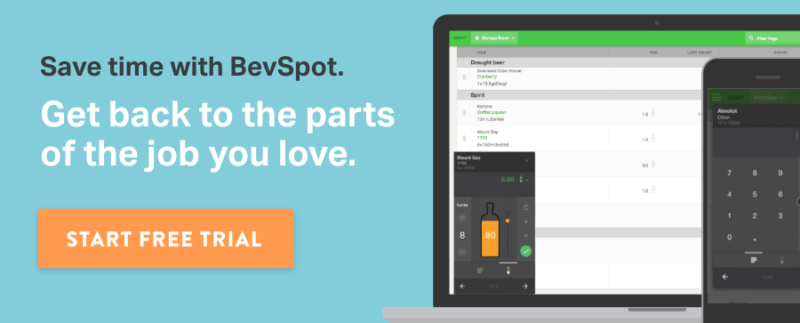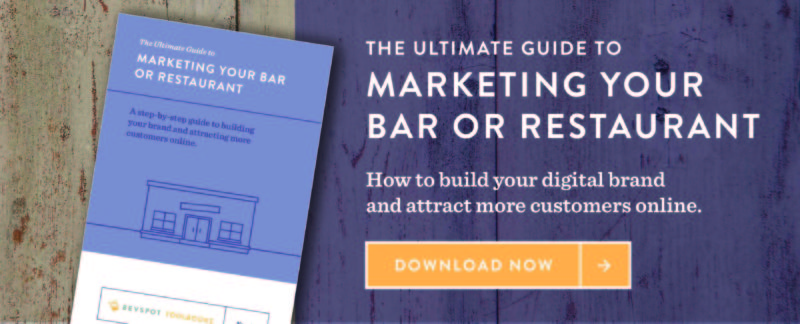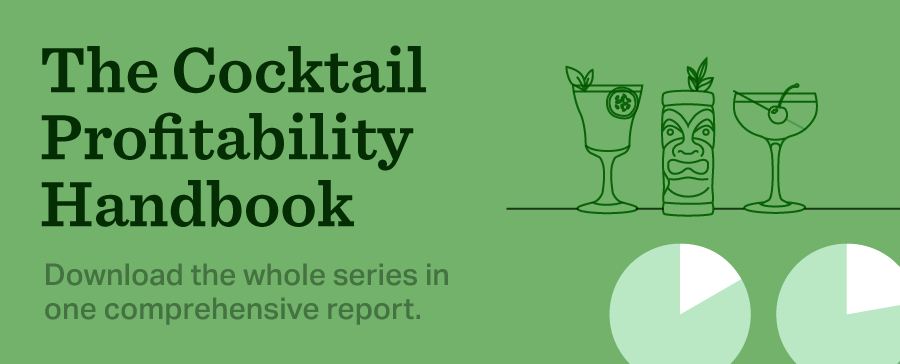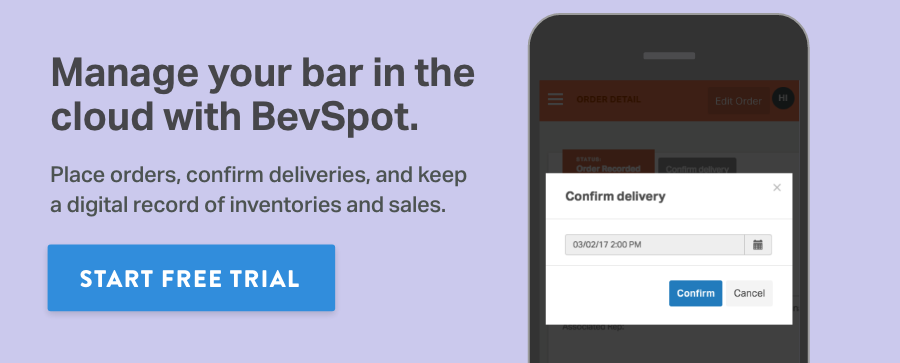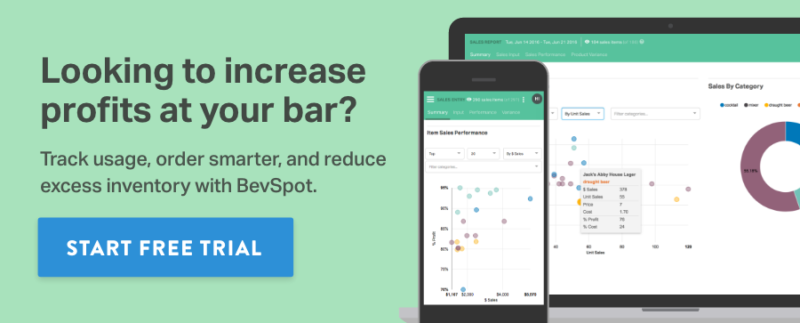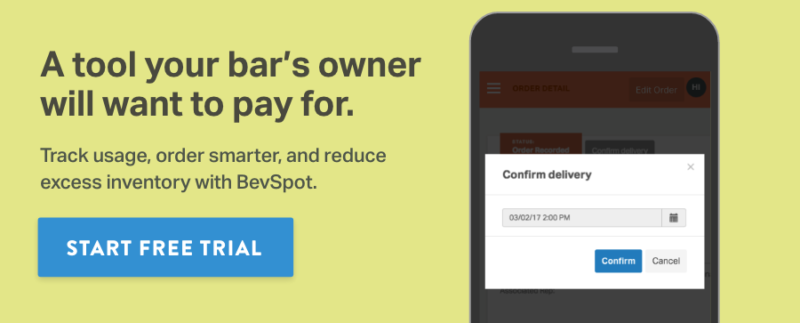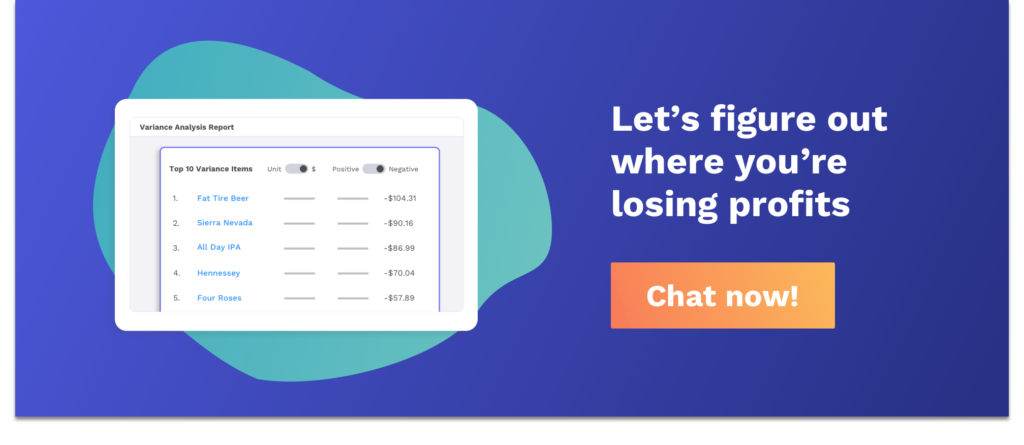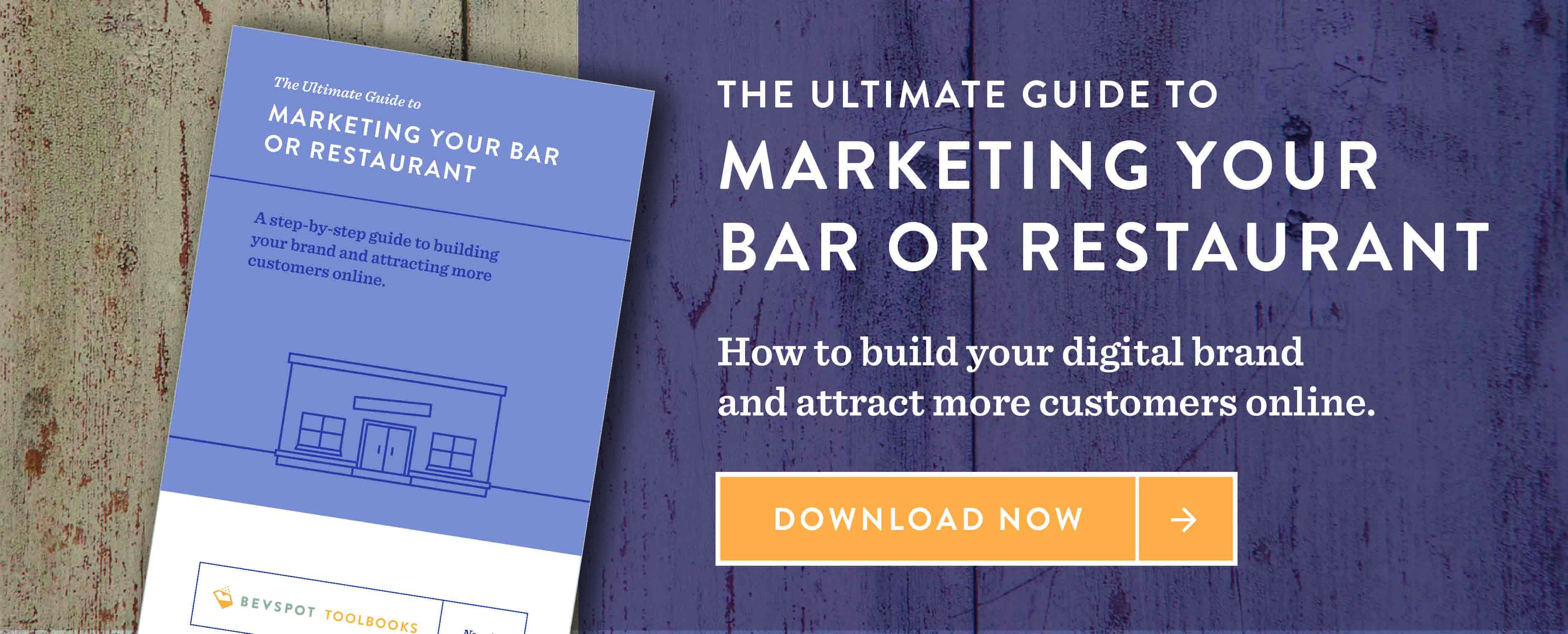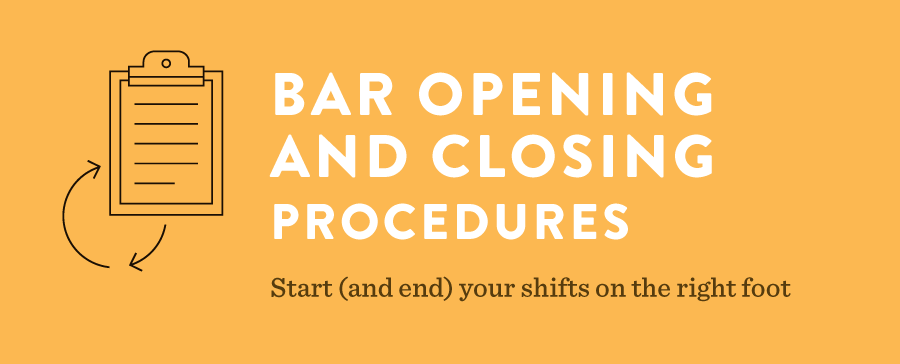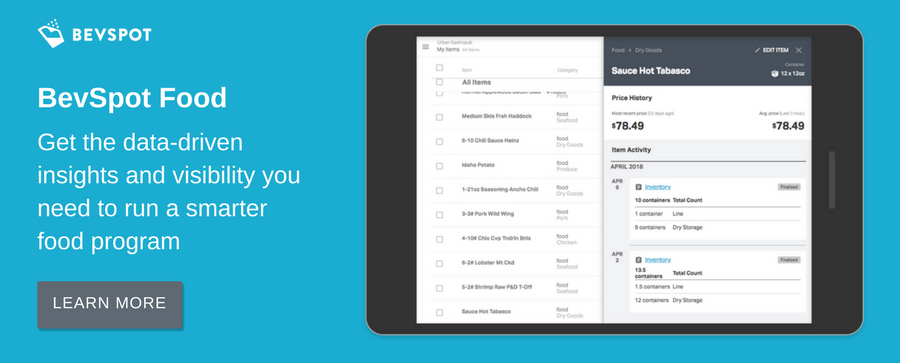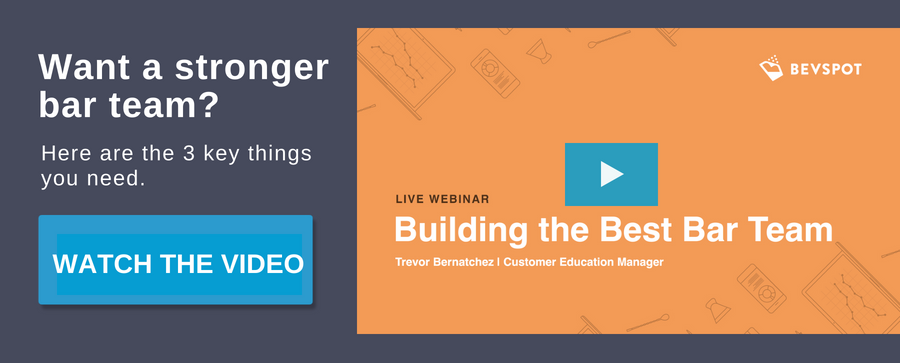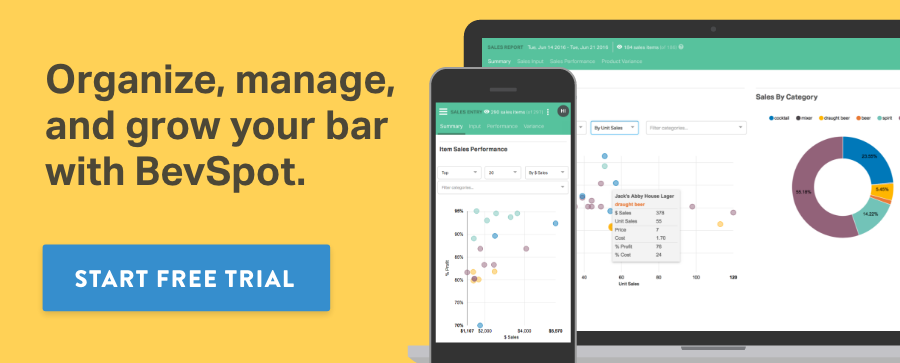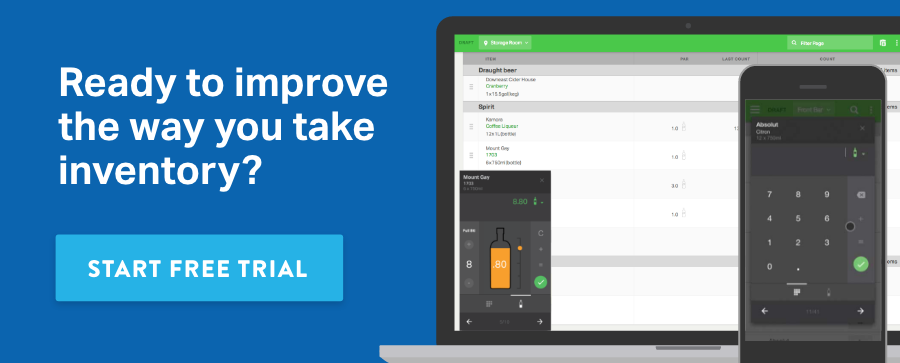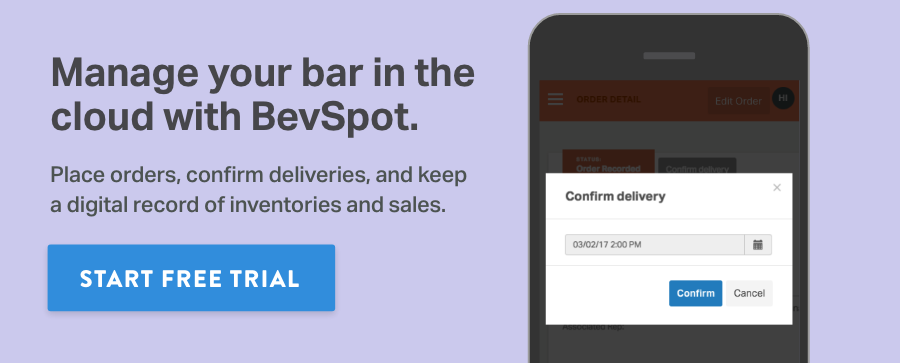Monitor Vendor Price Changes with BevSpot’s Price Tracker
![]()
Your bar is a well-oiled machine. You take regular liquor inventory, created a creative and profitable beverage menu, and identified ways to reduce your sitting inventory. But small details can always slip through the cracks, like keeping track of price fluctuations for every product you order.
Closely monitor price changes with the BevSpot Price Tracker
At BevSpot, we aim to create products and features that make a measurable impact on your bar or restaurant’s bottom line. The new Price Tracker feature does just that. Being able to track vendor pricing changes over time will allow you to make better buying decisions, negotiate contract pricing with your reps, and ensure you’re charging your guests the right amount to increase profits.
The Price Tracker lists the starting price, ending price, total spent, and the change in total spent for all of your items in your BevSpot account. Most importantly, the tracker identifies how much a price has changed over time. Did that case of pinot noir increase by 11% over the last quarter? Did the box of chicken thighs really decrease by 3% over the last month? Now you know, so you can make better decisions about reorders or adjust your menu prices to increase profitability.
The Price Tracker also allows you to:
- Group your data by vendor, category, or item type
- Filter your date range by the last seven days, four weeks, eight weeks, or a custom date range of your choice
- Hover over the ‘Total Spent’ price to see the entire price history for the item over your selected time period
- Looking for a specific product? Use the search bar at the top menu bar to find it quickly.
- Export your Price Tracker data to Excel easily, perfect for sharing with your owner or accountant
The Price Tracker is now available in the Standard and Pro plans for both BevSpot Food and BevSpot Beverage.
Haven’t tried BevSpot yet? Get your hands on the Price Tracker (and other cool features) for free for 14 days now.
How to Create the Most Useful Customer Survey
Get the Feedback You Need
No matter how well you know your restaurant, you can never quite see it from a patron’s point of view—even if you read every Yelp review. You and you team are too close to the day-to-day to understand what they experience when they drop in for dinner and a drink. Because of this, you should always seek feedback on how your guests perceive your restaurant. The customer survey or comment card is a great method for gathering this information. But to be useful, it has to be done well.
Here are the four steps to create a proper customer survey to receive valuable feedback.
1. Determine what you want to know
You first need to know exactly what information you want feedback on. Determine your burning questions.
You can gather information on many aspects of your restaurant experience:
- Menu, both food and drink
- Pricing and perceived value
- Service quality
- Ambiance
- Promotions or events
This may change over time. Surveys are particularly useful when opening a spot to gather immediate feedback, fix the kinks, and align with your guests’ expectations. A year in, feedback is equally important, but your questions may shift in focus.
2. Create a simple customer survey
It’s important to write clear, concise, and direct surveys. Any confusion over the questions will keep guests from filling out the survey. Moreover, unclear questions will give you muddled data, making the whole venture less than fruitful.
The best practices for writing surveys are:
- Keep the survey short: Long or time-consuming surveys are the main reasons people won’t fill it out. Limit yourself to five to seven questions, fewer if they require anything more than multiple choice or ranking.
- Ask one question at a time: It can be easy to run multiple questions into one another, especially with limited questions. Make sure each question only asks one specific thing to avoid vague answers.
- Use smart response structures: Use numbered response scales (e.g., answer scales of 1-5, where one is strongly agree and 5 is strongly disagree). This makes it easy for your guests to answer and yields accurate quantitative data you can track over time. Avoid binary “yes/no” or “true/false” answer options, as they provide much less useful information. You can, however, use multiple choice or fill in the blank to make some questions go quicker.
- Use digital surveys strategically: Digital surveys won’t provide in-the-moment reactions that table-side surveys do, but they may offer a different, and valuable, perspective. If you send out a newsletter, try adding an online survey asking for honest feedback from your most loyal customers. (Survey Monkey, Google Forms, and Typeform are all free tools with varying degrees of customization.) If you’re putting a survey on your website, consider putting very short surveys on relevant pages—for example, two to three questions about your bar program on the drink menu page.
3. Get people to participate
A less than shocking revelation is that people don’t love responding to surveys. But you want feedback so you can better serve your customers! So how do you get your guests to fill out the questionnaire?
- Offer a discount: Put a special deal on the survey. Whether it’s something you tack on to the end of the meal or offer on their next visit has different pros and cons. Offer it immediately, and more people will likely fill it out. Offer it later, and you can earn repeat business, but you risk people forgetting and not getting the survey back to you. If they respond online, maybe through a number or link on their receipt, you can email them coupons and add them to your mailing list.
- Hold giveaways: Ask guests for their email address on the feedback card, and enter every response into to a prize giveaway. (Random.org can help you pick an arbitrary person from the proverbial hat.) Giveaways allow you to offer a larger, more exciting prize and account for the cost in advance.
- Communicate it to guests: Make the survey part of your servers’ pattern at every table. Talk about the incentives for filling it out, how much your restaurant cares about hearing from it’s guests, and that it will help you better serve them. You can’t expect people to fill out a survey stashed behind the ketchup or dropped with the check if nobody has mentioned it.
4. Act on the data
The last step of the customer survey process is the most important one: implementing changes based on a critical mass of good, usable feedback. It’s easy to fall into two traps:
- Fixating on one comment—make sure you identify trends that should be addressed and separate singular opinions from the important feedback you will take actionable steps on.
- Not making a plan to rectify problems—talk to your staff about the feedback you’re planning to address and communicate the changes you expect to see from everyone.
Schedule 15mins to chat with a product specialist
Start a FREE Trial Today! BevSpot offers full product education and account setup for all customers! No card Information needed!
How to Start a Food Truck for Your Restaurant
“Why come to a restaurant when you can eat food out of the back of a truck?” —said someone very smart
With approximately 3 million trucks on the road in the U.S., food trucks have become huge business in the last decade, outstripping traditional restaurant growth 4-1. And contrary to what you might think, the arrival of food trucks has been a boon to the brick-and-mortar restaurant business.
Food trucks can be a viable additional revenue stream for your restaurant, but starting a food truck is a labyrinth of strict laws and regulations, long work hours, and likely a little bit of frustration.
Here are five things to consider if you’re thinking about expanding your restaurant with a food truck.
1. Build a strong business plan

At the end of the day, starting a food truck is like opening a second location of your restaurant. It’s a pricey adventure that requires careful planning to pull off and to make a profit.
Run the numbers: Know your break-even point going in. Account for everything, from the typical, like food and labor cost, to the specific, like truck maintenance and high fuel costs (you won’t be getting 30 miles per gallon in a food truck). Track you inventory to make sure you are not wasting, use either a spreadsheet or a food inventory app.
Know your town: Talk to people that know the space. Mei Mei, a successful food truck operation in Boston, MA that expanded to a brick-and-mortar establishment, knows a thing or two about this. “Make sure you know the current status of the city where you plan to vend and how many open spots there are, how much they cost, and what kind of foot traffic is present,” says founding member Margaret Li. “Talk to other business owners in the community, and see what they say about the state of the industry before jumping in.”
Know your goals—but be flexible: Margaret’s best advice for restaurateurs starting a truck: “Make sure you know exactly why you’re opening a truck and that you’ve run a full financial plan that fits with your [existing] restaurant. Our truck is now a dedicated catering truck rather than a lunchtime vending truck. We can plan our food and staffing better, and catering has become a huge part of our revenue stream.”
Use the advantages of your restaurant: You have a free, existing kitchen to work from—the number one challenge when starting a truck from scratch. You can buy in bulk, unlike restaurateurs who are exclusively mobile. You have a place to park and store food. You can advertise in-house. Your employees are already trained in the restaurant business.
2. Get all the permits

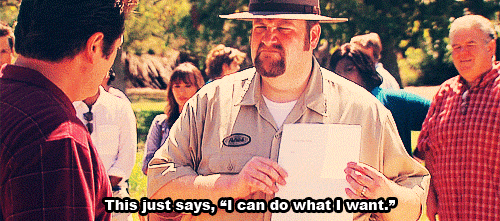
Every city, county, and state has restaurant rules and regulations. Food trucks are no different and can be much more complicated than traditional restaurant permits. You’ll need quite a few pieces of official paperwork to get going, likely including, but not limited to:
- Employee Identification Number (EIN)
- Doing Business As (DBA)
- Vehicle License
- Seller’s Permit
- Food Handling Permit
- Zoning Permit
- Signage Permit
- Tax License
- Gas, Electric, and Fire Safety
If you’re expanding your existing business, you may not have to repeat several of these. But it’s best to check locally if you need duplicate permits for your truck. You’ll also likely need these permits for every town you plan on operating in.
Don’t forget to check other local ordinances regarding food trucks, as well. Some cities ban food trucks altogether. Others limit the time they can park in one place or how close they can park to brick-and-mortar restaurants. Some require a bathroom to be nearby and accessible. Other cities only grant a limited number of licenses every year, so your name may have to go on a waiting list before you can be granted a license to operate. Do as much research as you can before diving in.
3. Embrace social media
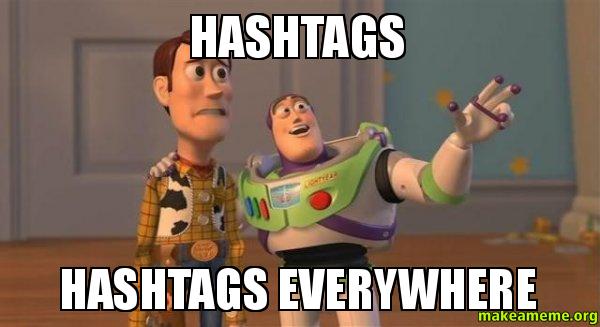
If you don’t already have a social media presence, get one—fast. If you’re already there, prepare to use it more than you ever have before. A permanent residence can afford to post every once in awhile—word of mouth and traditional advertising will get people in the door. But your food truck is always literally on the move, and folks should be able to find you easily.
If you’ve maintained a solid social media presence for your restaurant, you have another advantage. You can promote your truck’s debut and location on a regular basis to your existing audience. Make a big deal of it—have an opening day event, even if it’s in your own parking lot. Margaret’s advice is to start your truck promotion long before you open. “We threw pop-up events at local restaurants and started tweeting and posting menu ideas before we opened to get people excited about our concept.”
Make your truck’s schedule easily accessible and well broadcasted—if people go looking for you, you want to be found. Serendipity and assuming foot traffic is not a business model for a food truck. A good rule of thumb is to have your schedule posted at least a week in advance and a month in advance if you can manage it. Margaret’s golden rule is to be reliable and responsive. Posting regularly on Twitter, Facebook, and Instagram may be the difference between your new venture’s success and failure.
4. Channel your inner mechanic
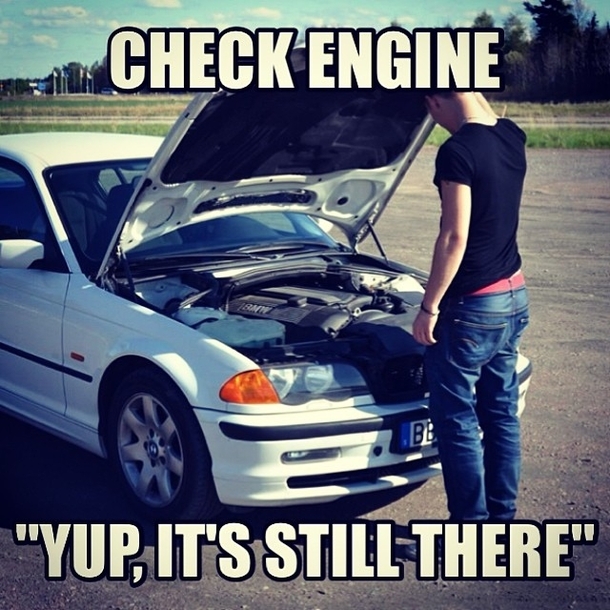
Even the most well-kept vehicle breaks down occasionally. And most cars don’t have a fully functioning kitchen inside them complicating matters. Nothing is more frustrating when running a food truck than sitting on the side of the road in the middle of a beautiful day thinking about all the food you could be making right now.
So it’s not a bad time to finally learn how to change your oil or a flat tire. Every bit of mechanical know-how from you and your staff is time and money saved. Be sure to get your truck looked over professionally on a regular basis and consider services like AAA—better to be prepared than sorry when a breakdown occurs.
5. Book lots of events and catering
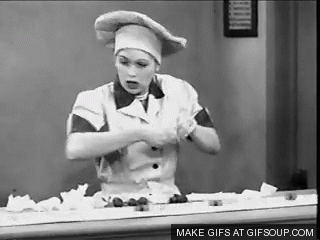
Very few food trucks survive solely by parking and hoping for the best. The real money comes from catering and events. Find the fairs, fundraisers, or sporting events that employ food trucks as vendors, or look for events in town specifically for food trucks. Send emails directly to organizers to get involved.
Margaret offers another good idea: “Make friends with other food truckers and restaurateurs so you can do fun collaborations and help each other out.”
Make sure people know what your catering includes, such as:
- Food cooked fresh right on site
- Customizable menus with flexibility for dietary restrictions
- Capable staff on hand
- Full-service options
- Expertise in hospitality
- Food cleanup
Follow these tips, and you’ll be on your way to a truck that runs smoothly and turns a profit for your restaurant!
Learn more about Mei Mei on their website and follow them on social ( Instagram | Facebook | Twitter).
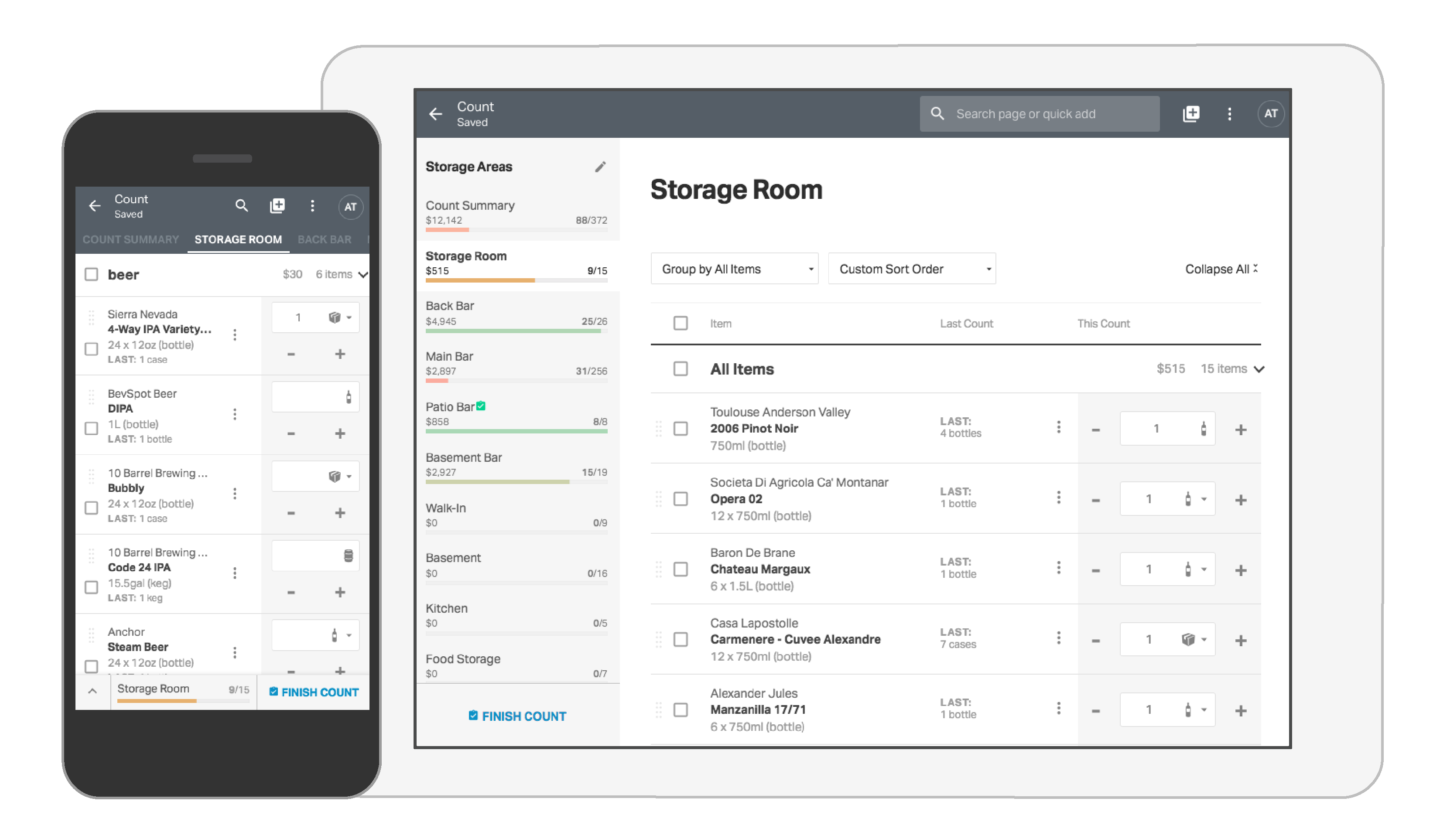
Schedule 15mins to chat with a product specialist
Start a FREE Trial Today! BevSpot offers full product education and account setup for all customers! No card Information needed!
Cocktail Chronicles: The History of the Dark ‘n’ Stormy & Rum Swizzle
To celebrate National Rum Day, we’ve got the history of rum and two of its most prolific cocktails: the Dark ‘n’ Stormy and the Rum Swizzle.
A brief history of rum
Some estimates date rum back to the 14th century in the Middle East, but the history of rum we know today is linked to sugar production in the Caribbean in the 17th century. Sugar cane was crushed to produce a juice that was then boiled and cured, resulting in a thick syrup we know as molasses. Originally considered pesky industrial waste (it was dumped into the ocean!), molasses was eventually fermented and distilled—and rum was born.
The history of the Dark ‘n’ Stormy: A tempestuous tale
The canonical Dark ‘n’ Stormy—the deceptively simple, spicy-yet-refreshing combination of dark rum and ginger beer—is often referred to as the national drink of Bermuda, renowned for its havoc-wreaking triangle.
The Bermuda Triangle is a 200-square-mile area considered to be the shipwreck capital of the world, with 300 identified sunken vessels lining its sandy depths (though experts claim the hull-ripping coral reefs are to blame rather than supernatural forces). There is where the Dark ‘n’ Stormy’s origin story begins.
In 1806, John Gosling, of the eventual Goslings Rum, managed to come ashore in Bermuda after 91 tumultuous days at sea and a successful crossing of the fated triangle. He settled on the island for good. Fifty-one years later, his family began producing rum. Through trial and error, Bermudians quickly realized what a perfect marriage could be made between the Gosling’s mahogany-colored rum and the sharp, effervescent ginger soda.
The Dark ‘n’ Stormy navigated it’s way out of the Bermuda Triangle on visiting ships that carried the recipe to places far and wide.
Do you know the most profitable rum drinks? We do. Click here to find out.
The history of the Rum Swizzle: Stirred, not shaken
Dating back to the 18th century, the Rum Swizzle is considered equally classic and is just as popular, thanks to the resurgence of tiki bars.
With three times as many ingredients—including two types of rum, pineapple juice, orange juice, grenadine, and Angostura bitters—it’s a bright, fruity foil to its stormy sister cocktail. But this cocktail is named for the method of making it rather than the ingredients. The original swizzle sticks were created from the branches of a tropical plant native to the Caribbean called the Quararibea turbinata—known colloquially as the swizzlestick tree. By the late 19th and early 20th centuries, swizzle sticks were being made out of materials like metal and plastic and were popular with the European elite, including Queen Victoria, who would use them to decrease carbonation in their champagne.
For a true Rum Swizzle experience, you can visit The Swizzle Inn, Bermuda’s oldest pub established in 1932, and purported “home of the Rum Swizzle.”
Now that you know a little more about these two cocktails, learn about other cocktails that will not only delight, but make you money.
Schedule 15mins to chat with a product specialist
Start a FREE Trial Today! BevSpot offers full product education and account setup for all customers! No card Information needed!
BevSpot and Toast Integration Helps Bars and Restaurants Succeed
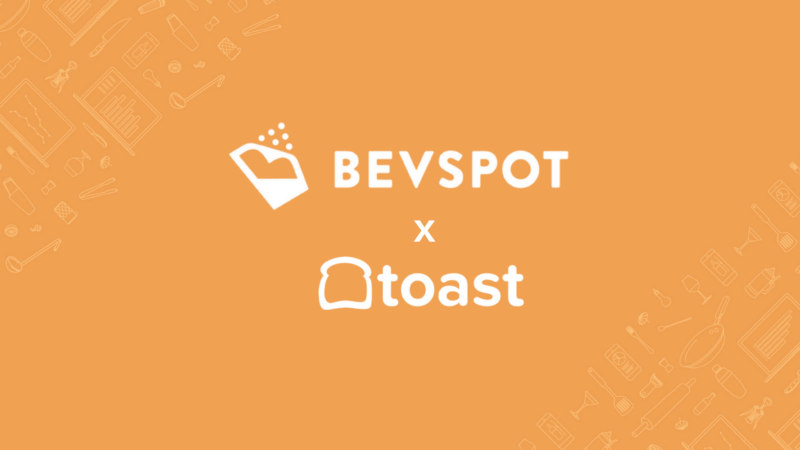
The restaurant industry has no shortage of technology options to choose from these days. But with the proliferation of apps and software to do every single thing in your establishment, the result can be lots of disparate systems providing useful but disconnected information. To make the smartest decisions, that data is often best understood holistically.
It would be ideal if key systems had a closer relationship to better support the success of your restaurant.
Enter the BevSpot x Toast integration.
Our mission is to empower the global food and beverage industry with technology, which means partnering with the companies that can help our clients, and the restaurant industry at large, move forward. This partnership ensures that BevSpot and Toast clients are able to seamlessly use their Toast POS sales data to make smarter ordering and inventory decisions and have even quicker access to the overall health of their business.
The out-of-the-box integration combines item-level point-of-sale data from Toast with inventory and ordering data available in BevSpot without the need for spreadsheets, uploads, or exports.
Our integration results in these key benefits:
- No uploads, no exports. There’s no need to log into Toast to export sales data. Sales stream into your BevSpot account for seamless integration. You can submit a report for processing simply by selecting the dates in BevSpot.
- Leave the data entry behind. Any new menu items will flow automatically into BevSpot, so you can manage recipes and cost out drinks without creating them one by one.
- Consistent terminology. The exact names and menu groups set up in Toast will be used in BevSpot, providing consistency across both platforms. This means clean data.
- Bye, bye duplicates. No need to complete steps in two places for systems that work best together.
“Whether you’re a single-location bar owner or CEO of a restaurant group, you’re constantly looking for ways to streamline operations and improve your bottom line,” said Rory Crawford, CEO of BevSpot. “As a Toast API Partner, customers will no longer have to wait for their Toast sales data to push over to BevSpot to view their insights. With this direct integration, the data will be at their fingertips in real-time. We’re proud to partner with Toast and are excited for what this means for the industry.”
For bars and restaurants looking for an integrated solution, Toast and BevSpot are pleased to offer an exclusive hardware-software discount. Interested users will receive the Toast Terminal Bundle and two months of the BevSpot Pro subscription for free—up to a $2,000 value.
Stay Organized with BevSpot Storage Areas
See the new updates to the Storage Area feature, plus three best practices from real BevSpot users for creating organized inventory storage areas.
The secret to faster inventory counts? It’s pretty simple: keep your product storage areas organized. But, keeping things organized is easier said than done, especially for large, diverse food and beverage programs.
Our team has been hard at work updating BevSpot’s Storage Area feature. Organizing and updating your Storage Areas is now even simpler, so you can take faster, more accurate inventory counts every time. Here’s an overview of some of the improvements we’ve made.
See all of your Storage Areas in one place
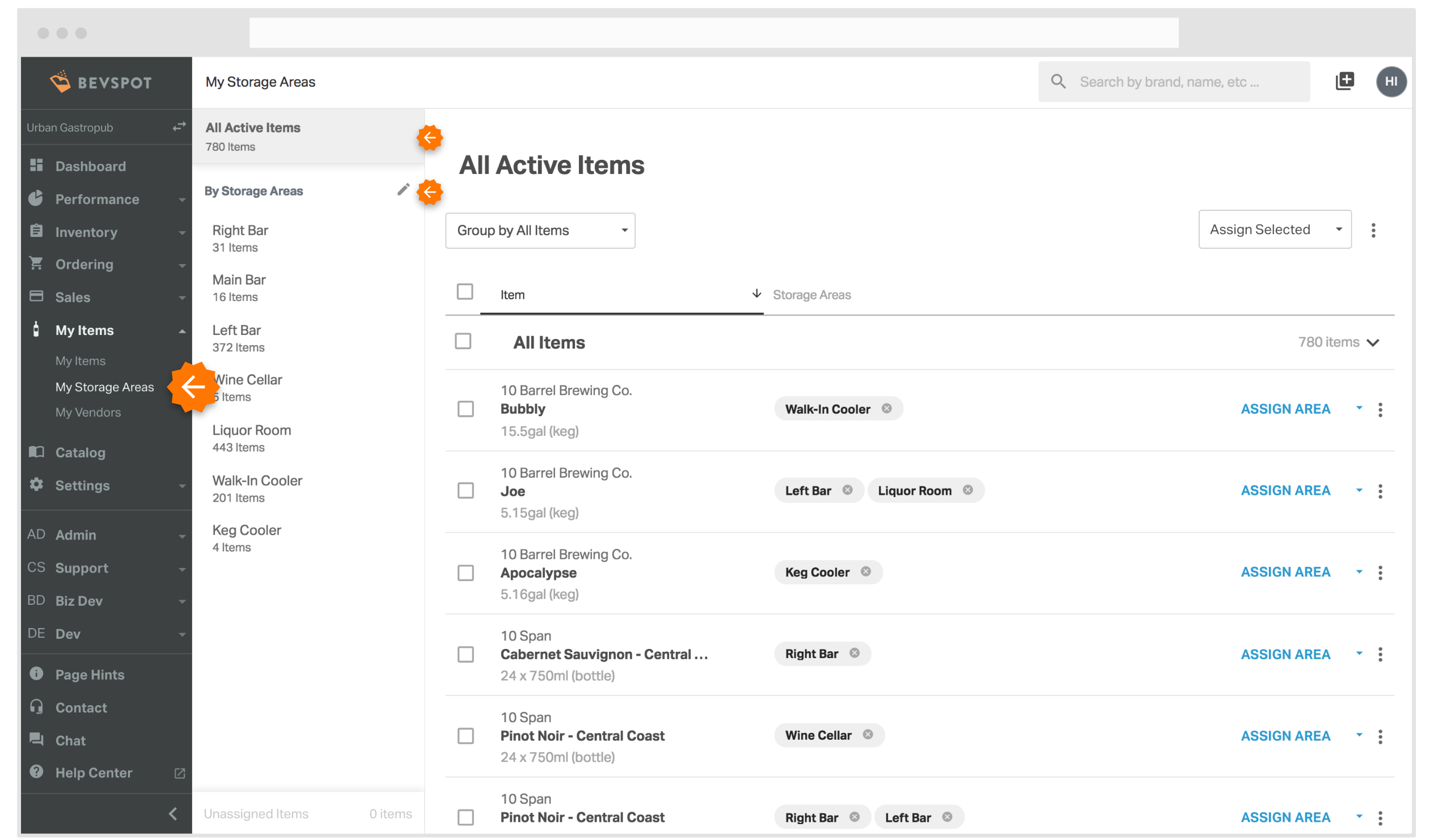
No more searching through an inventory count to access your Storage Areas. You can now find My Storage Areas listed under My Items in the side navigation. This is your home base for creating and renaming Storage Areas, assigning new or unassigned items, and identifying each location in your bar or restaurant that your item is meant to live in.
Filter by Storage Area
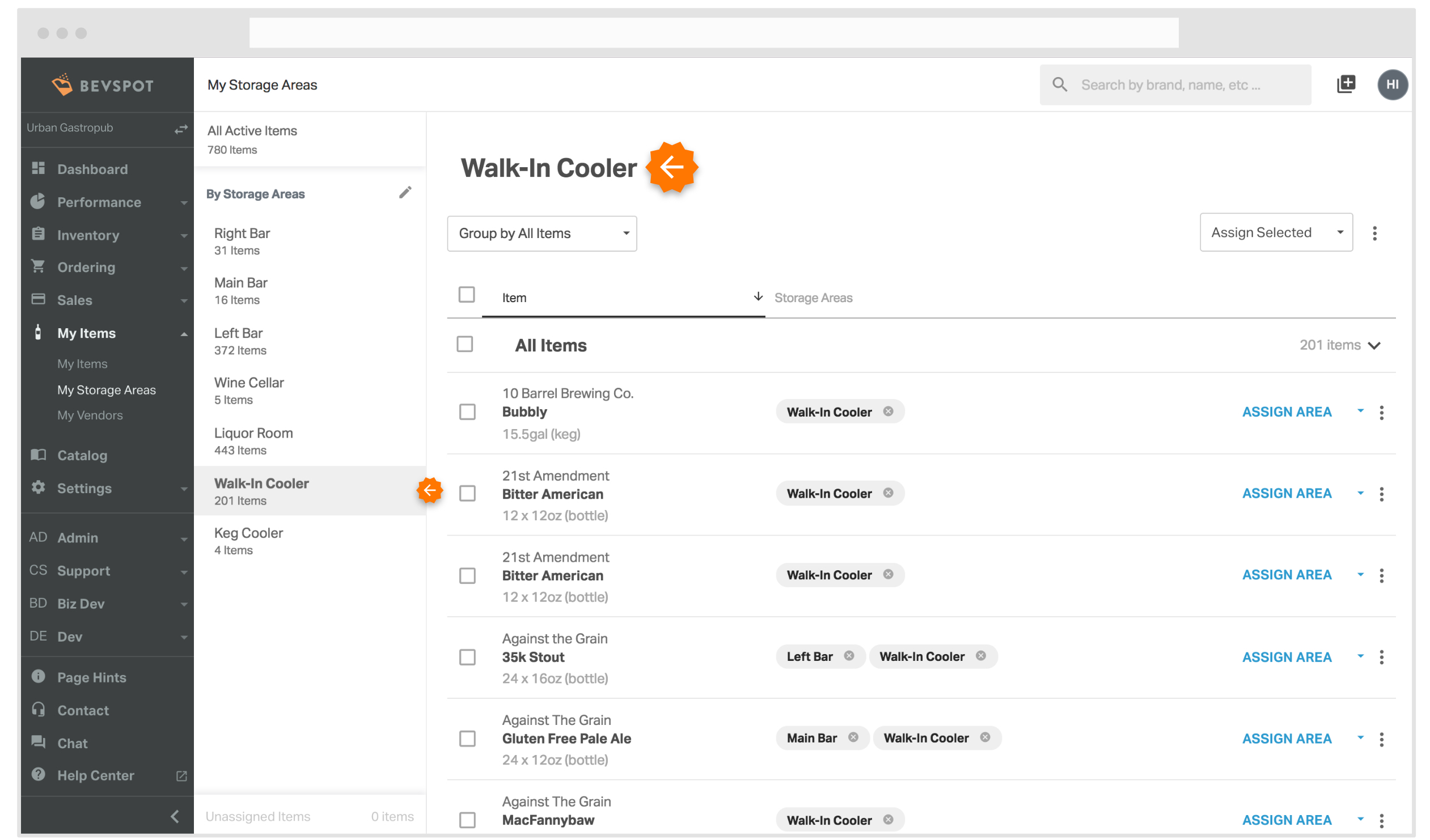
Filter by each Storage Area location to see the items stored there, and remove or assign items to additional areas on one screen.
Assign unassigned products to Storage Areas in an inventory count
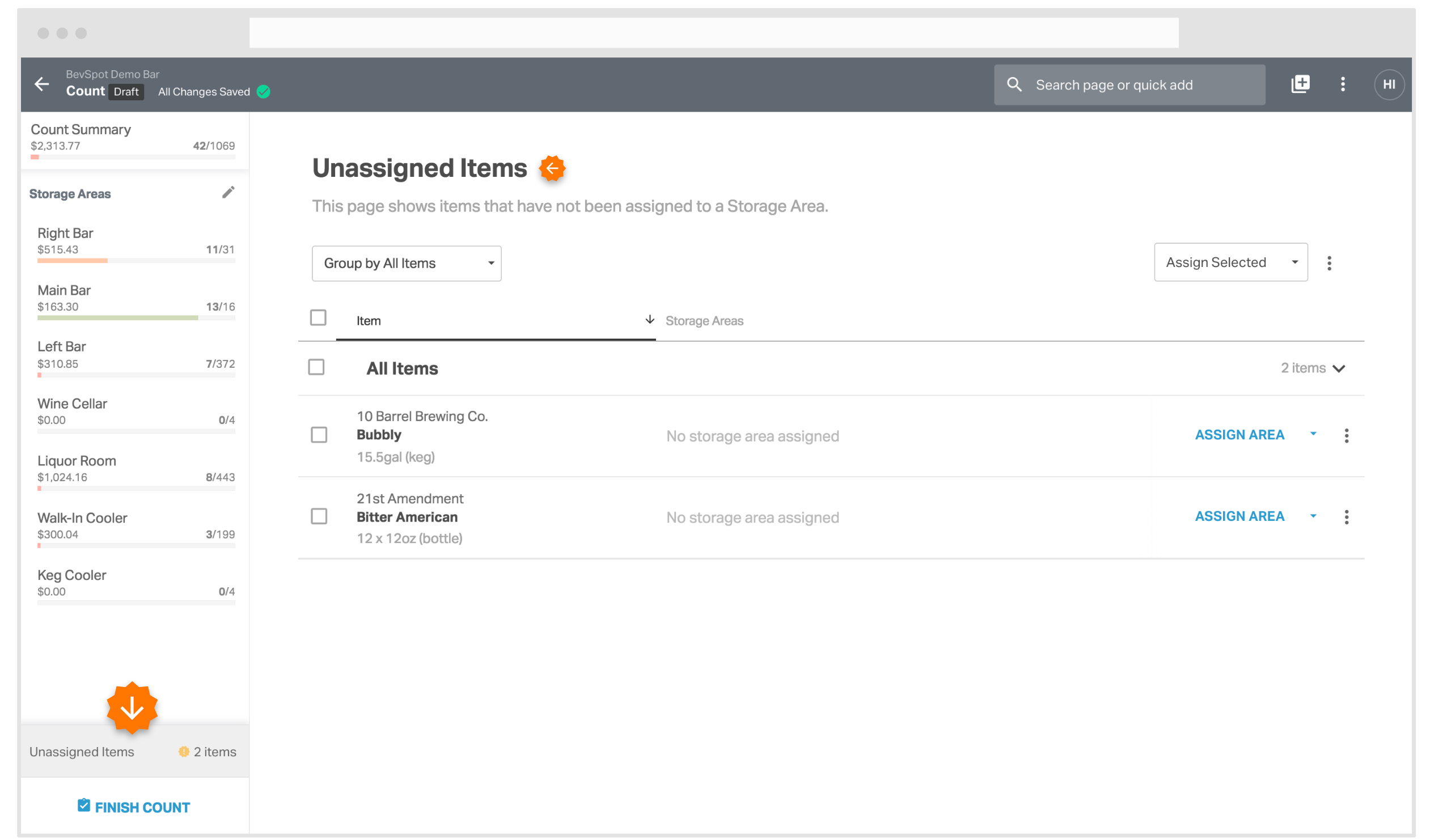
Imagine: You’re taking inventory and you suddenly realize the new bottle of Ketel One hasn’t been assigned a Storage Area yet. BevSpot now tells you when you have unassigned items in your inventory count and lets you assign them to a Storage Area without missing a beat. This Unassigned Item Alert is also a great reminder to first-time BevSpot users to organize their products before they start taking their first inventory.
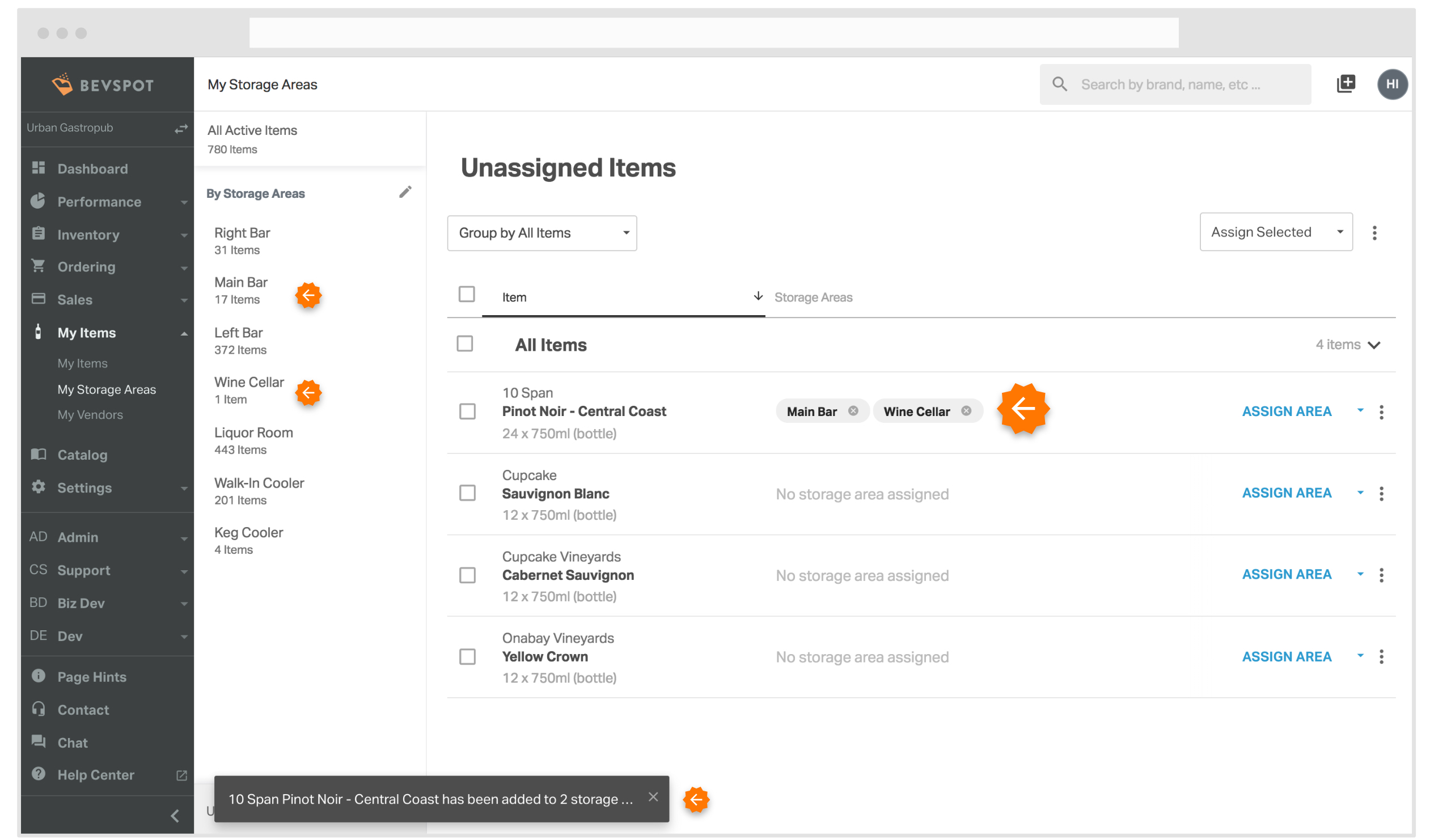
Keeping one bottle of Grey Goose in the main bar and the extras in the basement storage room? You can also assign a product to multiple Storage Areas at the same time.
Three best practices for creating smarter alcohol storage areas
BevSpot features are always built and updated with our users in mind. We spoke to two BevSpot users who are Storage Area masters to understand how they think about setting up storage areas within their BevSpot accounts.
Tip 1: Let the storage areas guide inventory, not the other way around
Beth Hoselton is the Bar Manager at The Hourly Oyster House in Cambridge, MA and was previously the Bar Manager at State Street Provisions in Boston, MA, both part of the Grafton Group. For Beth and her team, the alcohol storage areas guide the inventory process, not the other way around.
“It’s really helpful to be able to show people quickly and easily where exactly they need to be counting things,” Beth explains. “If I’m not there and I need a barback or my GM to [take inventory], it makes their life a little bit easier to be told step-by-step what to do. Storage Areas guides the inventory process.”
Chris Lamacchio is the Beverage Director for Joe Vicari Restaurant Group, an eight-brand restaurant group in Michigan. Chris trains his team to take inventory in each storage area a certain way to make the process easier. “When people try to combine multiple storage areas and count them together, that’s when the mistakes come into play. So I use the A-Z storage area thought process and group by item. At any given time, all your bourbons are together in alphabetical order so you can manage that left to right mentality.”
Tip 2: Get granular about your storage areas
When Beth was the Bar Manager at at State Street Provisions, she set up the BevSpot Storage Areas in a very granular way. “The bar itself was just so huge! When I was counting the main bar, I would count the bar top, the tower shelves, and then the back bar. So I had three or four separate storage areas just for the main bar itself. It made it a lot easier to stand in one place and count that area and then move and count the next area. Even if there were only five or six items in that storage area, it was really worth it to not be running around all the time.”
Chris also breaks down the major beverage areas of his restaurants into smaller Storage Areas, which makes his bar inventory counts more accurate.
“If I have a storage unit that is ‘up,’ and another storage area that is ‘down,’ I would consider them two different storage areas,” Chris says. “For instance, we have wine in the service bar and backup bottles in the bar area. It’s still two different storage areas. The bottles in the service area tend to be partial bottles, while the ones in the bar area are full. So when counting, it’s better to count left to right in one area versus trying to count two different areas together and combining full bottles with partials. That’s where mistakes happen.”
When setting up your Storage Areas in BevSpot, think about how you can create a organized hierarchy that makes sense for your space.
Tip 3: Organize your “must-move” items together so they’re top of mind
Chris uses the Storage Areas in BevSpot to manage the items he wants to focus his program on, such as items he wants to discontinue or move quickly. “Just today I pulled the items out of their regular storage areas and put them into a completely new place. The focus for the next couple of months is creating a ‘drink of the month’ that is very generic, so we can actually deplete some of this extra inventory and turn it into sales.” Chris can now track the usage of these items specifically to ensure that they are in fact moving.
Beth also encourages this out-of-the-box thinking to all bar managers using BevSpot. “My advice to bar managers is don’t be afraid to go into BevSpot and change things around and make it your own. Sometimes people get set in their ways and don’t change things because it’s going to be more work.”
Creating custom Storage Areas to organize your must-move items is an easy way to measure how well you’re successfully selling those items from inventory to inventory. If you’re sitting on less product an inventory or two later, you’re doing it right.
Curious how BevSpot can help your bar or restaurant get organized and take faster inventory? Try a free 14-day free trial today and start counting right away.
Schedule 15mins to chat with a product specialist
Start a FREE Trial Today! BevSpot offers full product education and account setup for all customers! No card Information needed!
BevSpot Industry Profile: Steve Havelock
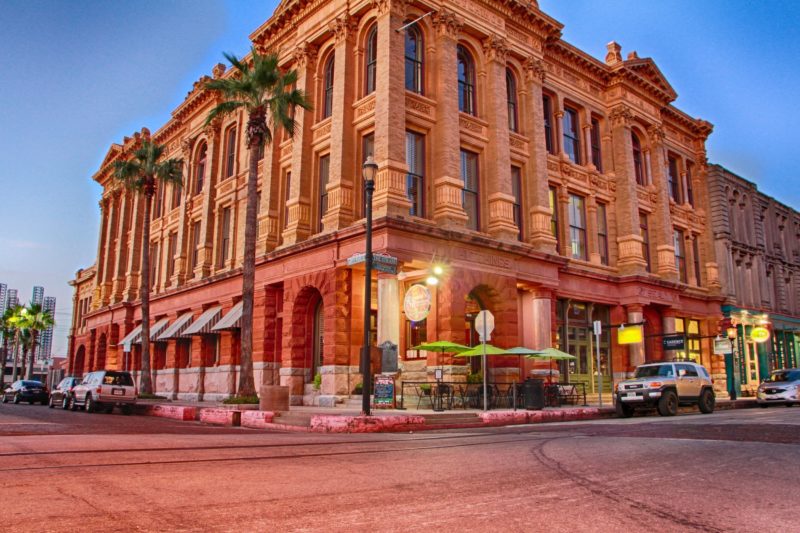
Steve Havelock is the GM of Riondo’s Ristorante, a fine dining Tuscan Italian restaurant in the vacation destination of Galveston, Texas. With more than 30 years’ experience in the restaurant industry (and other industries), he shares his perspective on current trends, how technology like BevSpot helps Riondo’s excel, and why he’d like to have dinner with Albert Einstein.
Location: Galveston, TX
Size: 90 seat dining room, 90 seat banquet space
Staff: 40 people
What’s the Riondo’s backstory?
There are two owners, which is where the name came from. The chef’s name is Rico and the the other owner is Don, everybody calls him Dondo, so the combination of the names became Riondo’s. Rico has been on the island for 30 odd years—he’s an excellent chef, very innovative. Don has a marketing background—he ran marketing for the U.S. Olympic ski team—and was a pro volleyball player. They were introduced four years ago by a local contractor who knew them both and Riondo’s was born.
How did you get your start in the restaurant industry?
Many, many, many years ago when I was a teenager I started in the hospitality business—actually in the kitchen, I wanted to be a chef. Then I got sidetracked into a computer career, and when I tried to retire to Galveston in the 2000s, I wasn’t ready for it. I worked for the previous owners of this building, so when Don and Rico came along, they asked if I’d continue in this position. All in all, I have about 30 years of experience.
Who are the biggest influences in your career?
I spent some time in New York, and I was fortunate enough to be there when Anthony Bourdain opened Les Halles. He was a great influence—I used to eat there a lot, I had the pleasure of meeting him a few times. He definitely had a different spin on things. I came from a more traditional background, and he kind of blew those ideas out of the water.
What are the most significant challenges you face running Riondo’s?
I think there’s a couple of aspects. One, social media—trying to manage all the different interactions that we have and responding to reviews on Yelp and OpenTable. There’s also maintaining a presence for the restaurant on Facebook, Twitter, and Instagram. Keeping that side of it managed is constant.
Two, being smarter about what we do. Obviously there are a lot of tools available, like BevSpot, that can help. We have two seasons here. During the summer, it’s very much tourist-related business. Fifty thousand people live here full time, but in the summer, it’s up around one to two million. Big difference! So in the summer we cater to tourists who are looking for quick meals to get back to the beach. In the winter we’re back to our local, regular customers, and they expect fine dining. It’s almost like two different restaurants.
What are some of the trends you’ve seen in the industry over the years?
I think there’s more pressure to be constantly innovative, especially with the menu. It used to be that people picked a restaurant because they knew it would have their favorites. Now it seems that people are looking for restaurants that bring something different, keep the menu fresh. Different generations have different expectations.
How has BevSpot helped you and the restaurant be better?
We’ve had BevSpot Beverage for almost two years. The two main benefits are ordering and sales data.
I have six or seven different wine and alcohol vendors, and I used to have to call in orders on the phone. There were always mistakes, the wrong things being delivered, misinterpretations of what we wanted. The ordering system has alleviated all those issues—I know exactly what I’ve ordered, when the delivery will come, and we can double check the expense to see what they’re invoicing for versus what they’ve actually delivered. That’s a great help, it’s cut down on a lot of expenses with unnecessary deliveries.
Inventory is obviously a big factor because it dictates what we’re going to order, and the sales side is great because we change our wine and spirit menu to fit the seasons. With sales insights we know what’s selling so we can make more educated guesses as to how to change the menu. You always have a gut feeling, but it’s nice to be able to look at real data to confirm your choices.
You recently signed up for BevSpot Food. How did you make the decision?
About three months before BevSpot announced they were going to do food, we signed up with MarketMan, which is only for the kitchen side. The owners had seen the benefits we were getting from BevSpot in FOH, and we wanted to collect the same ideas for the kitchen. So we started to use MarketMan, we had all our product uploaded and were doing weekly inventories, and then BevSpot announced the food product! From a business point of view, we didn’t want two systems, and we decided to cancel MarketMan and switch to BevSpot for BOH.
The benefit is going to be inventory. The kitchen is definitely a little more old school than FOH. Even if we can get a sense of what’s in the inventory, that’s a big step up from where we’ve been.
Best meal you’ve ever had?
I visited the Savoy Hotel a few years ago, and they prepared a very traditional Dover sole which was filleted at the table. It was pretty impressive.
If you could have dinner with one person, dead or alive, who would it be?
Albert Einstein. Fascinating guy. I’m sure I wouldn’t understand half of it, probably only 1% of it, but I think it would be an interesting conversation!
The Most Popular Beer & Liquor Brands of 2018
“What can I get you?”
We have the answer.
It’s been a few months since our last report on the most popular beer and liquor brands in the United States, and we’re back with new insights on the top-selling booze brands of 2018 so far.
The following report aggregates alcoholic beverage orders and invoice data from hundreds of U.S. BevSpot users for the first half of 2018. All figures represent percentages of orders in dollar terms.
BevSpot is one of the leading applications for both beverage and food inventory management.
How to Manage Online Restaurant Reviews the Right Way
Here are five best practices for managing online restaurant reviews.
It’s an unfortunate reality that any business has to deal with: managing unsatisfied customers. Thanks to the influx of review platforms like Yelp and TripAdvisor, sharing personal experiences at local businesses—good or bad—is easier than ever. As a bar or restaurant professional, your business (and reputation) can live and die by these reviews. It’s important that you handle all online restaurant reviews with care and respect.
Build and monitor your online presence
You want to make sure people can find your restaurant in the clutter of online search results. According to a Bright Local survey, 97% of consumers looked online for local businesses in 2017. Once they find your restaurant, you also want people to talk about you. We’re all a little skeptical of a restaurant with only two reviews.
Every bar and restaurant should be active on social media. Platforms like Facebook, Twitter, or Instagram are perfect for promoting special deals, events, and showcasing new menu items. But, you can’t simply set it and forget it. Posting content regularly helps you build a community of patrons and can help your restaurant get discovered by new guests.
Claim your business listing on popular review sites such as Yelp, Google, and TripAdvisor, and take the time to complete all profile fields. Show off your restaurant with professional photos, and get people excited about your dishes by uploading your menu.
Do your research before responding
It’s always best to have the facts before responding to a negative review. Read it closely. Then talk to your staff to get their impressions. Don’t be accusatory, but get a full picture of what happened before responding.
While you’re at it, read the reviewer’s other posts as well. Do they make a habit of one-starring places? Are they always inflammatory? Or does this seem to be an isolated incident? Getting whatever sense you can out of the person you’re responding to is invaluable, as there’s no face to face conversation from which to pull context clues. Giving yourself even a little context can make the difference in how you respond.
Detach yourself personally
Be honest: bad experiences, no matter the reason, frustrate all of us. The anonymity of the internet has a tendency to amplify loud, angry people. As an industry professional, you can’t give in to the emotional temptation of responding to anger with anger.
How you react matters. Remember, what you do on the internet lives forever. To avoid going viral for all the wrong reasons, remove your emotions from the equation. Hear the customer out and try to see the experience from their point of view.
As personal as these reviews may feel, there is value in negative reviews if you consider it constructive feedback. Keep track of the feedback you’re receiving to identify trends, such as “the food is too salty” or “the drinks are weak.” Every quarter, review these trends with your team to find opportunities for improvement.
Respond to all online restaurant reviews
People leave online restaurant reviews because they want to be heard. Whether they’re good or bad, you need to be ready for anything. Of all the things you can do with bad reviews, ignoring them is one of the worst. In fact, responding can improve your reputation. According to a Harvard Business Review study of hotel reviews on TripAdvisor, when hotels respond to negative reviews, they receive 12% more reviews and their rating increases by 0.12 stars on average.
If someone leaves a negative restaurant review, start with a private message. Acknowledge their review, tell them their concerns have been heard, and follow up with clear next steps and actions. Then respond to their negative review publicly. You don’t want potential customers wondering why you haven’t responded to someone’s concerns. Be professional, polite, and make the reviewer feel respected.
The same advice applies to positive reviews. Any time someone shares a positive experience, publicly thank them for their comments. In either case, sincere responses shows that you care about the customer.
Dealing with fake reviews
Fake reviews are a real, malicious, and hard to control. Many review sites don’t require users to post under a real name and Yelp only takes down reviews that violate their terms-of-service. If you think you’re dealing with fake reviews, gather up as much proof of fraud that you can, and present it to the website with a request to have the reviews removed. Beyond that, legal representation may be required for a particularly malicious string of reviews.
At the end of the day, your best tool against negative and fake review is to maintain an active and positive online presence. One negative online review may turn a few people away. But for most patrons, watching you actively solve problems, engaging with positive reviews, and showing that your care will win them over in the end.
Schedule 15mins to chat with a product specialist
Start a FREE Trial Today! BevSpot offers full product education and account setup for all customers! No card Information needed!
Related Articles
The Right and Wrong Ways to Handle Bad Online Reviews of Your Bar
How to Approach Reservations and Waitlisting Technology Solutions
Restaurant Owners: Why “Good Enough” Won’t Cut It
BevSpot Industry Profile: Korgen Hospitality
1. Please introduce yourself and tell us about your current role at your company.
I am Ken McGarrie, and along with my wife, Morgen Klepfer, we launched Korgen Hospitality. We are dedicated to working alongside passionate restauranteurs to elevate both the guest experience and the bottom dollar.
2. What makes Korgen Hospitality unique?
Beyond a comprehensive, in-depth knowledge of the industry, Korgen makes recommendations to restaurant owners on how to improve their business—even beyond the scope of what Korgen itself might supply. When establishing a custom list of services, it is common for us to say to restaurateurs, “Here is a step-by-step list of actions you can take to improve your operations on your own.” Sometimes an owner will successfully tackle these challenges internally, and we are happy to have played a role in their accomplishments. Oftentimes, a restaurant simply doesn’t have the personnel to execute the strategy effectively, which is where Korgen Hospitality comes in to help.
3. How did you get started in the food and beverage industry?
Morgen started as a door host of a trendy nightclub, and Ken began as a dishwasher/mouse mascot for Chuck E. Cheese. Although we took separate paths—Morgen developed a loyal clientele base as the premier Chicago events and catering contact, and Ken worked to open numerous exceptional venues in both the U.S. and Canada—we share a true appreciation for genuine hospitality.
4. Who or what were some of your biggest influences as you got started in your career?
Our biggest influences have always been our most memorable dining experiences. We find inspiration at each extreme end of the pendulum:
The moment when a server assistant graciously replaced a fallen napkin at Gramercy Tavern that motivated a discussion on being present without being obvious.
The genuine way a bartender at Dinosaur Bar-B-Que made a menu recommendation that changed a fundamental training practice.
5. What drives your passion for the industry?
We have met so many people who opened restaurants for the sheer love of serving others. They are good people who have a dream of inviting the community into their kitchen to enjoy their family’s recipes. Unfortunately, that desire doesn’t always equate to profitability and they find themselves in challenging circumstances. Our passion is working alongside these visionaries to make sure they are around for years to come.
6. In your opinion, what are the biggest challenges facing the industry today?
The biggest challenge today is the same as it has always been—creating a buzz that inspires people to visit a venue. Fortunately, social media has become a powerful tool, especially in the hands of the consumer. Online reviews and posted pictures are the truest form of word-of-mouth, and work to drive traffic toward (or away from) a business. Restaurants who opt to ignore these outlets do so at their own peril.
7. What role do you think technology plays in taking on those challenges?
Technology is the answer for our biggest challenges, and smart owners channel their online reputation accordingly. Many restauranteurs have a negative opinion of review sites, but it is the best way to continue the conversation with guests outside the four walls of the venue. The antiquated restaurant waits to develop Instagram content, while the visionaries utilize it to create a buzz 3-6 months before opening.
8. In your opinion, what are the greatest opportunities for the industry in the future?
The greatest opportunities are found in systemizing controllable expenses. Having software which cross-references three food vendors for the best pricing helps drive down costs. Technology that links food and cocktail recipes with inventory and invoicing allows restauranteurs to react quicker to negative trends. The success of any business is to be nimble, and platforms like BevSpot are making it easier to manage.
9. What role does quantifiable data play in your day-to-day?
Above-store data allows restauranteurs to gain real-time perspective on a host of important factors. Reporting software (like Avero) sends owners daily sales reports, labor percentages and management logs. Scheduling platforms (like Hot Schedules) monitor overtime, forecasts labor impact, and bridges the communication gap between manager and staff. Inventory software (like BevSpot) tracks usage, pars, and controllable costs. Gone are the days of cobbled-together data—now it’s simply waiting in your email inbox each morning.
10. Tell us about your most memorable culinary experience.
Morgen: I would have to name Schwa in Chicago. The tasting menu was incredibly inventive, and the service was truly genuine. The restaurant is intimate, only 26 seats total, and is the epitome of chef-driven. And did I mention heavy metal played at full volume?
Ken: I would pick Fabulous Freddies Italian Eatery in Bridgeport. When I first moved to Chicago, my friend insisted that my first meal was a hot dipped beef at Freddies. When I moved away, I searched for that taste. But, as much as I like cheesesteaks and po’ boys, nothing beat the memory of that Italian Beef. It was so authentic and made me feel a part of the city. It’s not the only reason I came back to Chicago, but it was absolutely the first meal I had again when I returned.”
Want to Host Live Music at Your Bar? Start Here
Hosting live music in your bar
Hosting live music in your bar or restaurant is one of the most classic, time-tested event strategies in the history of the business. But, like most things, you’ll find that there’s a surprising amount of specialized work that goes into running a successful music event. Here are six steps for successfully hosting live music at your bar.
Listen to a demo or see them live
We’ve talked before about how you should match the band to your bar’s demographic. But, simply picking a music genre isn’t enough. Accurately describing bands by a prescribed genre—punk vs. rock vs. alternative—is so difficult because there are so many variations and nuances with music. Simply interviewing a band doesn’t really give you a good impression of what their music sounds like.
Similarly, bands that you find through advertising sites or bands that contact you directly about playing a gig aren’t necessarily, well, good. Asking to hear a demo or recordings of them playing at similar venues will give you a good feel for their style, sound, and energy.
Want to experience their vibe for yourself? Ask them if they are playing another bar near you and pay them a visit. Experiencing a band live is truly the best way to decide if they are a good match for your bar.
Get it in writing
You always want to get any kind of agreement in writing. Formal details, such as arrival time, set length, payment schedule, conduct rules, and whether you intend on comping food and drinks for the band should be understood and legalized from the beginning. This protects you in the case of a bad experience, and makes life easier in the case of a good one.
Contracts are also helpful for tracking your experience with a band. Take notes of every act you hire for future reference, so when you’re getting ready to either rebook a band or research someone new, you have a paper trail to reference.
Do I need a license? Probably.
While you may not be playing the music yourself, as the owner of the bar, you are still responsible for acquiring all the necessary permits and licenses.
If the band you hire plans on playing cover songs, you’ll need to purchase a copyright license from a performing rights organization (PRO). These organizations make sure that the songwriters and publishers get royalty payment for the use of their songs. In the United States, the three PROs are:
Keep in mind, paying for a license with one PRO may not cover every song that a band plays. It’s safe to get a license with all three to avoid any copyright issues.
Once copyrights are covered, make sure you get the proper city and state permits to host live music. For instance, in the city of Boston, establishments need a live entertainment license if they want to host instrumental and vocal music, karaoke, a DJ, dancing, or theater shows—a pretty broad range of activities. Some towns or counties may even have different permits for amplified music vs. acoustic. Do your homework!
Consider charging a cover
Depending on the band’s popularity and where they are in their career, they could potentially pull in a fairly large crowd. This is great. In fact, it’s the entire idea behind hosting live music! But, you don’t want a large group of friends or family coming in to show support without buying anything. Charging a cover, even if you offer a first-drink-free promotion, ensures that you don’t lose money in the deal.
Run a sound check
No band worth their salt opens cold. Schedule the band to come in during off hours and run a sound check. Getting everything set up and tested early can relieve a myriad of woes. You’ll be able to test the volumes and ensure the speaker alignment is broadcasting a decent sound (a bad one will leave you cranking the volume for a similar effect.) Doing the sound check ahead of time also gives you space to set up the floor layout before anyone starts filling in the tables and standing room.
Record the event
Once you’ve gotten the proper permits, paid the appropriate licenses, and signed contracts, start promoting the event. Advertise each event on your website, on your social media channels, and in the bar itself. Consider recording each live event and devoting a page of your website to live events, or show off the event highlights on your bar’s Facebook or Instagram page. You can use this video portfolio to attract new acts or as free advertising for those curious about your live shows.
There’s a lot to consider when hosting live music in your bar. But when it’s done right, it’s both a great draw and a fun experience. Rock on!
Schedule 15mins to chat with a product specialist
Start a FREE Trial Today! BevSpot offers full product education and account setup for all customers! No card Information needed!
How to Start a Brewpub: 3 Things to Consider
How to Start a Brewpub
We’ve said it before, but the craft beer movement is here to stay. So who’s responsible for the the craft boom? The little guys.
According to the Brewers Association, microbreweries (defined as breweries that produce less than 15,000 barrels per year with 75% or more sold off-site) accounted for 60% of craft’s category growth in 2017. Many microbreweries start off as brewpubs, a restaurant-brewery that sells at least 25% of its beer onsite. Brewpubs grew by double-digits in 2017, up 15% from 2016.
More and more restaurants are starting their own brewpubs to capture the attention of craft beer enthusiasts. You may be asking yourself, how do I start a brewpub in my restaurant? We share a brief rundown of the legal steps you need to take, the challenges to consider, and perks of starting a brewpub.
Boring, yet crucial: Get your licenses in order
As with most things, you’ll need some special paperwork to get your brewpub operations off the ground. While it may not be a requirement, hiring a good lawyer should be one of your first steps. You may already have one on retainer, but make sure he or she is familiar with the type of permits and licenses you’ll need. Having a competent and dedicated lawyer aboard will give you peace of mind that everything is taken care of, but it also gives you the space to focus on creating a great beer product.
Next, you’ll need the appropriate licenses and permits. Of course, alcohol laws and regulations vary state by state, but a few brewpub laws and permits you should be aware of include:
- Growler laws
- TTB License
- Food and Drug Administration (FDA) Food Facility Registration
- Beer label laws (if you plan to sell bottled or canned beer)
- State-specific Brewpub License or Brewer’s Permit
Proper research, trademarking, and consulting with a lawyer will smooth this process out.
Choose a beer distribution channel
One of the biggest challenges any new product company faces is figuring out how to distribute their new product. As an established bar or restaurant, you’ll have a head start. You’ll likely start out by selling your beer at your own bar. Beer on tap, growlers, and eventually bottled or can packs are a great start (and stop if you want to keep it that way.) But, what do you do when you want to sell your beer beyond your doors?
You have two options: self-distribution or working with a distributor.
Self-distribution vs. distributor partnerships for microbreweries
If you have the manpower, self-distributing your beer is a great option for brewpubs looking to keep profit margins high and control which bars and shops sell their product. Self-distribution is currently legal in 36 states. The major downsides of self-distribution include higher upfront costs for labor, delivery trucks, and warehouse space. It also limits your ability to sell the beer across state lines.
On the other hand, large distributors have extensive knowledge and resources that solo brewers don’t have. They can help you reach new customers in a given geographical area, deal with delivery logistics, and give you time back to focus on your business.
What’s your beer flavor profile?
You’re legally approved to share your beautiful beer vision. You have a sales plan, projections, all the legal paperwork in place. Now comes the art; the sweet, bitter, malty, hoppy, science. What kind of beer do you make and why?
Most brewers make a range of different beers to cater to a wide palette. Use your existing inventory and sales data to understand your customers’ tastes. Likewise, if you notice a trend your current lineup isn’t fulfilling, now you can create something to fill it yourself.
Set up your brewing operation
Now it’s time to get brewing. Consider your brewing equipment setup into your space design. Do you plan on leasing an off-site building? Do you have space on your property to build an extension? Do you have room to fit your fermenters, kettles, and tanks in your existing infrastructure? If you do, will it all be on display and viewable by your patrons? Depending on what your space allows and the aesthetic you have in mind, placement can make a statement about you and your business.
From the flavor profiles, to the labels you create, everything works together to serve your beer’s overall brand. Make a statement with them. Design gorgeous bottles and labels. Create intriguing and fascinating copy. Aspire and experiment with recipes that will make people come to your brewpub to get your unique flavor.
An enterprising restaurateur should always look into ways to expand their business. Opening your own microbrewery or brewpub adds unique flavor to your restaurant, creates new revenue streams, and allows for incredible levels of menu customization. It’s work, and it’s a long process, but it’s ultimately a rewarding one.
A Conversation with BevSpot’s New VP of Product: Nichole Mace
We’re excited to introduce Nichole Mace, BevSpot’s new VP of Product. In this interview, Nichole tells us more about herself, her thoughts on what makes a successful Product team, and which projects she’s most excited to sink her teeth into.
1. Introduce yourself and tell us a little bit about your background.
I’m Nichole Mace, the new VP of Product at BevSpot. I am really excited to join BevSpot at such an exciting stage of the company.
I have worked in Product for the majority of my career, and have had many positive influences that have shaped my view of what it takes to successfully deliver really good products. One of my first jobs was at a startup that was bought by Intuit. In the early days, Intuit was heavily focused on “doing right by the customer at every juncture,” even if it conflicted with other objectives. I loved this way of thinking about good product, and ultimately it has defined my career.
That experience has led me to consistently seek out product roles at companies that are driven by doing right by the customer. This has included technology startups like Constant Contact and Quilt, and more established companies like Zipcar. Each of these experiences has reinforced my belief that product plays a key role in a successful customer experience.
Personally, I am from Delaware and have spent my adult life in Washington, D.C. and Boston. I went to undergrad at the University of Delaware and got my MBA at Babson College. I am married and have a 12-year-old son and 10-year-old daughter. I am passionate about yoga, hiking, cooking, and all things tech.
2. What attracted you to BevSpot?
I was initially attracted to BevSpot because of Rory’s (BevSpot’s CEO) drive and focus as an entrepreneur. He has a strong vision of what he wants the company to be, including a focus on the customer. As I learned more about the team and opportunity at BevSpot, I realized that there was a strong fit with my interests and experience.
BevSpot is at a really attractive point in their development, where my experience and vision around product can have a real impact. Early in my career, I spent seven years at Constant Contact growing the company from 10 to over 150,000 customers. I lived the SaaS model and spent my time tailoring the product to the needs of the customer, improving conversion and customer satisfaction, and maintaining low customer churn.
3. Based on your experience, what are the components of a successful Product organization, especially at fast-growing startups?
I see five primary components to a strong and effective Product organization:
- Clear roadmap consistent with company goals: Product is responsible for creating and maintaining a clear, flexible roadmap that supports the company’s goals. A deep understanding of the work ahead for the next few sprints is a must, a good view of the quarter ahead allows for more thoughtful and efficient development, and the 3-12 month view shows (to our best guess) what we’ll be doing. When new things come up, it makes the trade-offs clear as to what needs to be pushed out or dropped off.
- Real customer research: What makes a product (and Product team) great starts with a deep understanding of the problems you’re trying to solve. Customer surveying, data analytics and, of course, qualitative research is key to achieving understanding and uncovering the “why.”
- Killer UX + UI Design: Designing an experience based on customer research, that is enjoyable, easy, and visually pleasing is no small feat, but critical to getting to the “wow!”
- Aggressive testing and iterating: I’m a huge fan of usability testing live or online, although some product enhancements are best tested in the wild with A/B tests or limited releases.
- Communication: They say most messages are successfully communicated after seven times. Product is responsible for communication—from product strategy, to user stories, to customer messaging.
4. What role do you think technology plays in solving challenges for the food & beverage industry?
I see this industry as an especially good fit for leveraging technology, given that such a large percentage of restaurants and bars fail within the first few years. Technology can offer visibility and insights that lead to cost and time savings and increase the likelihood of businesses success.
Specifically, the ability to run leaner and increase available cash with smarter inventory management could be a game changer for many bars and restaurants. With technology in place, food and beverage businesses can move into the world of data-driven decisions and management.
5. What excites you about BevSpot’s approach to solving these challenges?
I have always been a big supporter of SME businesses, like bars and restaurants, because they are the companies that are truly innovating. Leveraging technology to enable these businesses to be successful is a way to level the playing field versus larger players in the food and beverage industry.
Playing a role in this type of disruption is truly exciting and BevSpot’s commitment to customers, and culture around empowering this innovation is especially exciting to me.
6. What project(s) are you looking forward to sinking your teeth into?
Trial Conversion: I look forward to understanding why some customers decide to buy after a trial and why some do not. Digging into which customers have which problems and what is being solved or not by BevSpot.
Once identified, these problems will help to guide the roadmap and be great fun for team building—brainstorming, testing, and iterating on solutions. I’ve always found trial conversion to be a glorious area of focus for product because improvements can be easily measured.
Cross-sell Optimization: While at Constant Contact and Quilt, I spent a good portion of my time experimenting with cross-sell and understanding what leading behaviors and customer attributes made up the top segments who were likely to buy the next product. While the products are different, I am curious to see if it similarly boils down to a few factors that drive customers to cross-sell. Also, I’d like to better understand if there are features in the Beverage product that could make it a more natural and easier cross-sell for BevSpot Food.
Churn: Once the trial period ends, what are customers looking for long-term? What levers transform an average user to the super user who relies heavily on BevSpot to grow and run their business? Is there added value in the BevSpot experience that could be considered that would drive down churn?
7. What do you hope to accomplish at BevSpot?
This one is easy: “to create BevSpot champions and promoters around the world who feel that they can’t do their job without BevSpot.”
Also, I hope to develop an innovative and cohesive Product & Design team that, along with Engineering, produce the top product experience in the category. My favorite teams are those with complementary skills that can push each other to be their best. I’d like for the Product & Design team to be a key driver to the company’s success in reaching its goals.
8. What’s your favorite “off-the-clock” drink?
I always love a Mojito with extra mint in the summertime.
3 Hiring Tips for Building Amazing Bartender Teams
We all know it; employee turnover is a huge problem in the food and beverage industry. According to the U.S. Bureau of Labor Statistics, the annual employee turnover rate in the restaurants and accommodations sector is 73%. Think about that for a second. That means that only a quarter of your employees will still be around at the end of the year. Recruiting, hiring, and training new people is costly and time consuming. The best way to avoid it? Hire an amazing bar team from the beginning. Easier said than done.
In our most recent webinar, Customer Education Manager Trevor Bernatchez, gave us 3 bar hiring tips for owners who want to create a thriving work culture that will keep those star bartenders and bar managers at at their bar.
Tip 1: Craft a winning bar work culture
(04:15)
Why is culture such an important part of hiring and running a successful bar team? Your work culture ultimately defines expectations around how the bar team is meant to function before, during, and after a shift. Trevor has seen first hand how easy it is to lose control of culture. “In 15 years in the industry, I worked in many different establishments, and I can probably count on one hand the number of truly functional teams I got to be a part of. That’s just sad!”
Your bar managers and head bartenders are the ones who’ll help you cultivate and maintain culture. Trevor explains the six basic traits effective bar managers need to have in order to create an effective team work culture.
Helpful Resources:
Tip 2: Become a master recruiter and interviewer
(11:45)
So, how can you actually find qualified candidates for your bar? You may work 60+ hour weeks running your bars and restaurants, but you gotta get out on the town!
- Visit the industry hangout after a shift
- Research events happening near you
- Tap into your Facebook (yes, Facebook) network
- Get creative with your job listings
The applications are rolling in, and you’re ready to start interviewing. There’s an infinite number of questions you can ask a candidate, but here are a handful of key interview questions to ask potential bar team members:
- How do you cut off patrons?
- How would you make [sample drink]?
- What do you know about our menu or venue?
This is the point where you should channel your inner psychic. Trevor explains some key body language cues to watch for during the interview.
Tip 3: Build a training plan that creates accountability
(17:50)
Everyone learns in different ways, so build an adaptive training program that is geared toward results.
- Create formal checklists for key procedures ensure everyone is on the same page in your bar
- Software solutions like POS systems, scheduling tools, and bar inventory and sales performance insights software help you manage of every component of your bar business
Helpful Resources:
Schedule 15mins to chat with a product specialist
Start a FREE Trial Today! BevSpot offers full product education and account setup for all customers! No card Information needed!
BevSpot Industry Profile: TJ Zlotnitsky
TJ Zlotnitsky is the President and CEO of iControl, which works with retailers to improve direct store delivery transparency and collaboration with their vendors.
Tell us about yourself, iControl, and your role within the company.
My brother Sean and I were both born in Israel and came to the United States when I was 12 years old in 1986. I then grew up in Maryland, where I also went to college. My brother and I started iControl after our family’s wholesale distribution business was sold in 2008. We learned a ton in that business about workflow inefficiencies and points of conflicts between food and beverage retailers and their distributors, and we felt that we could bring technology to the market that substantially simplified and improved process and outcomes for both trading partners. We set out to create a company that offered ways to reduce conflict and tension and pave the way for greater collaboration between retailers and vendors. Nine years later, we are helping tens of thousands of retailers and thousands of vendors do exactly that.
How did you get started in the food and beverage industry?
My father started a wholesale distribution company that serviced the food and beverage industry in 1986. I spent my youth and most of my adult life in this company, CNC, where I rose from apprentice to CEO. Under our leadership, the company eventually distributed to customers in 33 states.
In your opinion, what are the biggest challenges facing the industry today?
In my opinion, the greatest challenge the food and beverage industry is facing today is catering to consumers—especially those from the X and Y generations, who increasingly expect optimal convenience, choice, and flexibility, yet have been conditioned to believe that great value doesn’t always mean having to pay a premium price.
For traditional brick and mortar retailers, meeting these kinds of expectations at a bargain price is exceedingly difficult. Success requires an equal measure of innovation, moxie, and thrift. Achieving those three things require the ability to operate with maximum efficiently, while measuring key metrics constantly and effectively.
What role do you think technology plays in taking on those challenges?
Technology is the only way to meet and overcome these challenges. To me, successful food and beverage retailing today requires a level of precision that is akin to laser surgery. The margin for error is so small that just doing it the old way is a guaranteed way to fail.
In your opinion, what are the greatest opportunities for the industry in the future?
I am actually very bullish on the food and beverage industry figuring out how to leverage physical presence within communities to “out-Amazon” macro-competitors, whether it’s Amazon itself or some other behemoth. Food and beverage could prove the exception to the macro-digitalization of commerce, in that physical proximity to the end consumer can and should be a sustainable competitive advantage for local operators. But—and this is a big but—that competitive advantage will only be sustainable to operators who are aggressively focused on playing to their strengths: proximity, accessibility, freshness, and value. And as I said earlier, that requires operators who don’t waste time and money on inefficient business practices and are constantly measuring and recalibrating.
What role does quantifiable data play in your decision making process?
Quantifiable data plays a critical role in my decision making, but I think it’s important to not ignore other variables. Let me offer an analogy all of us can probably relate to:
Have you ever followed your car navigator instructions to the point that you ignored what was right in front of your nose? Turn right, when the airport is clearly on your left? I’ve done it. We all do it.
There is a lesson in that for all of us: Data and technology are fantastic, and they are essential, and anyone not embracing both would be nuts. But at the end of the day, I try to use data to inform my decisions, not to entirely substitute for my judgement.
How do companies like iControl help the industry move forward?
iControl is a unique company, in that we focus our solutions on solving the workflow challenges of the direct-to-store supply chain, such as alcohol distribution to a typical restaurant, or bread or dairy delivery to a typical grocery store. The direct store delivery (DSD) supply chain is massive in size and incredibly disaggregated, with numerous systems of record and a high degree of complexity around data synchronization and automation of B2B financial transactions. iControl provides our customers with both a toolset to streamline workflows with their DSD trading partners, as well as robust analytics to assess performance in as near to real time as possible in order to identify both net positive and net negative contributors to outcomes, and rapidly adjust behavior.
When you’re “off the clock,” what is your go-to cocktail or beverage?
I am a huge, huge fan of very spicy bloody Mary. I mean, very spicy. I usually add hot sauce and a whole bunch of jalapeños. If I can still feel my mouth after finishing my drink, I consider it a failure!
Party On: 5 Bar And Restaurant Event Planning Tips
No matter how popular your bar or restaurant is, there are plenty of ways to maximize income (and avoid the “good enough” trap.) One of the best ways to bring in more revenue and patrons? Host private events. Restaurant event planning isn’t as simple as closing your establishment for the night and carrying on with business as usual. We’ll arm you with five key event planning tips for bar and restaurant owners so you can start hosting memorable events right away.
Why should I host private events at my restaurant or bar?
Private events are extremely profitable. According to Gather, the average party size of full-service restaurants is 3.7 guests, which returns $50 to a couple hundred dollars per party. Gather notes that the average large group or private event spends around $2,500—five to 20 times the average revenue per table. And since many of these event contracts require upfront payment or a deposit in the form of a percentage of the total cost, it’s guaranteed revenue for your restaurant business.
Five restaurant event planning tips
The biggest mistake restaurateurs can make is jumping into restaurant event planning without a clear strategy or process. There are five things to keep in mind as you start planning your events strategy for your bar or restaurant:
- Create a standard event process
- Build a standard event menu
- Consider offering unique experiences
- Acquire necessary permits and licenses
- Partner with local organizations
1. Create a standard event process
From the servers, to the kitchen staff, to the front of house, your entire team needs to be prepared for every event. The best way to do this is to create a standard event planning process for each team.
Keep a detailed calendar of all events, so you don’t overbook your venue. Formalize the contract paperwork so that, going in, everyone knows what to expect; the number of guests, the cost per person, and fees due at each stage of the process. If you standardize the parts of the event that are the same every single time—such as scheduling or client contracts—you can focus on the individualized, customized parts of the event and make them shine.
2. Build a standard event menu
Does your chef have a favorite dish that’s not on the main menu? Do your bartenders have a specialty cocktail they don’t get to craft as often as they would like? Event menus are a great place to show off your creativity and make the patrons feel like they’re being treated to something special. Some restaurants even work with their clients to design a one-of-a-kind menu that fits a concept or theme for the party.
But, before you start getting wild with menu engineering, make sure you create a menu that’s both crowd-pleasing and profitable. Standardized menus makes it easier for you to price costs and maintain a specific profit margin.
3. Consider offering unique experiences
While some services might be too niche, expensive, or time consuming to run on an everyday basis, a private event with a guaranteed (or even prepaid) headcount allows you to widen your offerings. Just because you aren’t a karaoke bar doesn’t mean you can’t offer karaoke. Make the night truly unique and something your patrons will talk about and recommend to friends. Hold a live concert. Host a poker tournament or an escape room. Teach the delicate art of knife throwing.
4. Acquire necessary permits and licenses
Speaking of knife throwing—depending on the type of event you’re hosting, you may need special permits, licenses, or insurance to legally cover them. Take the time to research statutes and regulations in your area. Failure to adhere to these regulations is a quick path to large fines, which cuts into your event revenue. For instance, hosting live musicians need a special kind of license. Hosting a poker or casino night? Your staff can’t just deal cards without becoming certified by an official board. Make sure you include any liability language in your final contracts. Failing to follow through and obtain the proper documentation could potentially be disastrous to your bottom line and business.
5. Partner with local organizations
To host private events, you need large groups. Partner with local facilities—like hotels, convention centers, or local businesses looking for retreats or team-building events—that can provide a steady stream of customers. Becoming an official partner with these businesses can also lower your marketing budget and can attract new, regular customers as well.
A private event is a fun and different night, for both your clientele and your staff. But that doesn’t mean it doesn’t require specialized work. The best thing you can do is standardize as much of the work as possible, protect yourself against damages, and throw yourself into the work. This is a night to display something different, something truly unique. It’s a night to display passion and grow your business. Have fun!

